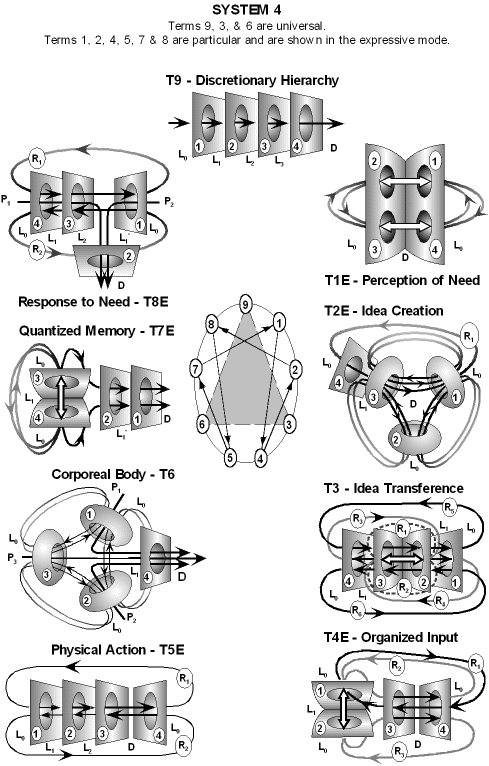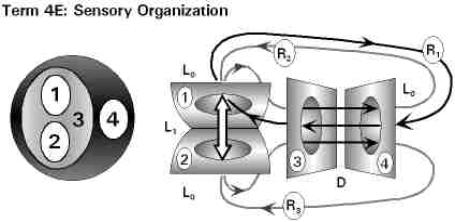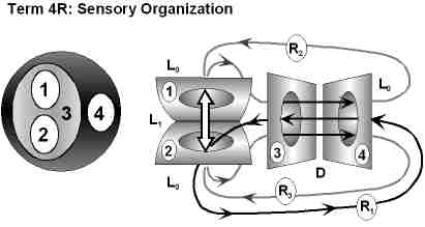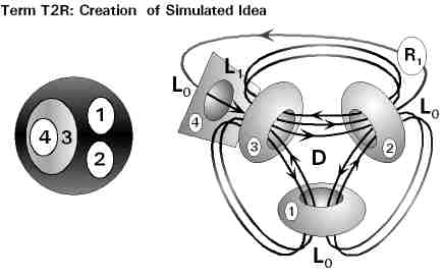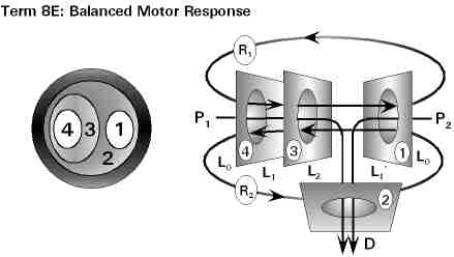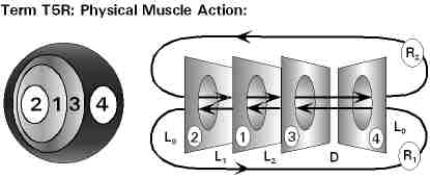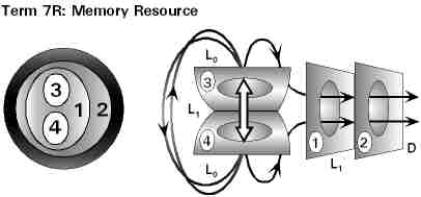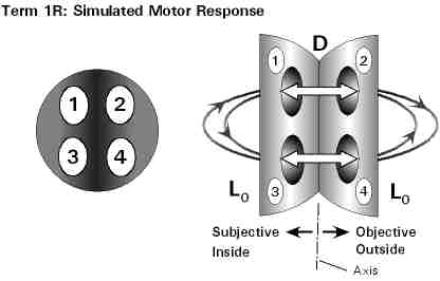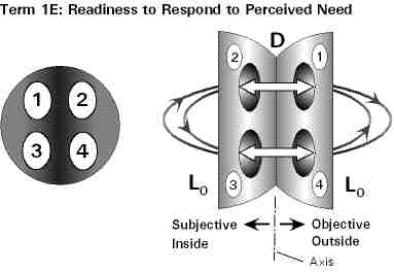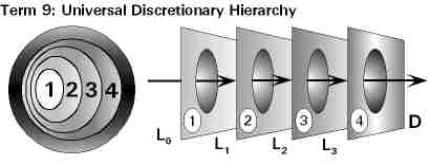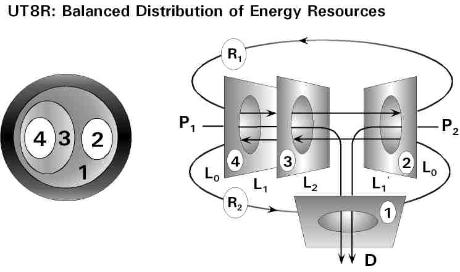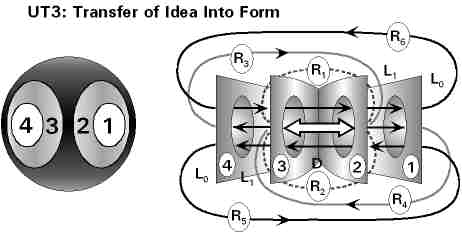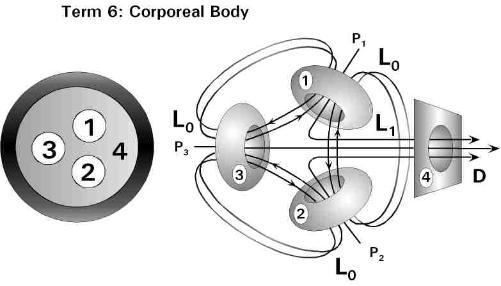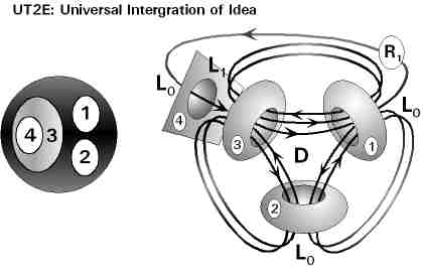Back • Return Home
System 4 Terms
Robert Campbell 1976, 1985, 2005
Abstract
System 4 is generated by four active interfaces between a universal active inside and a universal passive outside such that neither inside nor outside can be known to the exclusion of the other. All we can ever know is active interface processes between them. There are only nine ways that four active interfaces, called Centers, can mutually relate with respect to their common inside and outside. Each way is called a Term that implicity defines meaning both within the context of the Term and in relation to other Terms.
Fig. 1
A visual representation of the nine terms of System 4 are shown in expressive mode. The meaning implicit within each Term derives from the orientation of the four active Centers and the patterned energy flows that link them up in each case. All meaning derives from the way the System works, since it embraces all possible structural varieties of experience. A readable general account is given in Fisherman's Guide to the Cosmic Order.
Term 9 belongs to a Primary Universal Set with its own transform sequence. Terms 3 and 6 belong to a Secondary Universal Set with a related but independent transform sequence. The remaining six Terms belong to three separate Particular Sets that follow one another through the six Term transform sequence as indicated by the arrows, but one transform Step apart. Terms 8, 7, 4 alternate with Terms 1, 2, 5 in separate Sets. A basic outline of the Terms and how they work is given below. This should be sufficient for the interested reader to get an initial insight as to how it applies to our nervous system and body.
Summary Notes on Active Interfaces
Active interfaces between a common inside and outside are represented by active surfaces consistent with System 1. They are called Centers (C1, C2, etc.) since each has an active center inside designated by Light (L) that relates across one or more active interfaces to a common periphery outside represented by Darkness (D).
Everything that we perceive in phenomenal experience involves active interfaces. Everything from atoms and molecules to light itself consists of a form of patterned energy relating to itself across active interfaces. Most active interfaces or Centers are illustrated by open plane surfaces of indefinite extent. This generally indicates archetypal characteristics that are not bounded in themselves. They are bounded by a subsuming context.
For example, in a Primary Universal context, all human Organs and Cells have a contextual relationship to the archetypal Host of all humanity. In a Secondary Universal context, open interfaces represent the processes of all Organs and Cells as they relate to one Host human being. Since the Primary and Secondary Sets work together to integrate the Particular Sets, each human Host is a member of the human Host species. In other words, the primary set relates to the species while the secondary set relates to the individual member of the species. This is true of any biological species.
Closed Centers are represented by a Triad of ellipses. Only triadic relationships are mutually closed and defined in spatial extent, in the way that System 3 defines one primary hydrogen atom as electron, proton, and photon energy shell. In a self-similar way, Cells, Organs, and each Host human being are intimately bound and mutually interdependent. Each member of the triad is dependent upon the other two. Each exhibits a closed surface between inside and outside as it relates to the other two. Closed triadic relationships can work in a variety of ways in the higher Systems, but we will not be exploring that here.
The Universal Hierarchy
As outlined in other System 4 articles, there is a System 4 hierarchy involving 4 active Centers (C) that implicitly give direction to one another. The four active interfaces are an elaboration of the three active interfaces that generate System 3. Knowledge is distinguished from Idea in System 4, since a monolithic Idea does not allow of diverse phenomena. The distinction thus derives from the same Rift in Universal Wholeness that gives rise to Systems 2 and 3 from System 1. Each higher System must elaborate on the nature of Universal Wholeness through the creative process.
The human nervous system will be used to exemplify each of the nine Terms and how they work in a general way. If the reader wants more detail, synapse by synapse, refer to the articles entitled The Nervous System - Part 1 - Spinal Cord and The Nervous System - Part 2 - Cerebellum.
The System 4 hierarchy is as follows:
(C1) Idea → (C2) Knowledge → (C3) Routine → (C4) Form
The words associated with each Center are very general indications of meaning associated with the structural development of meaning within each of the nine System 4 Terms as they may apply in any circumstances. It is noteworthy, even remarkable, that these four words structurally define coherent meaning within each Term as they dynamically relate to one another in the evolving matrix of interactions through the 12 Step Sequence outlined below.
We can see that the hierarchy applies to any human activity. There is always an Idea that gives direction to our learned Knowledge that in turn directs a Routine of visceral and muscular activity that results in an altered Form of the body in concert with the Form of the environment. The hierarchy is universal and is designated by Term 9 of System 4. If we focus on the neurological and muscular processes that animate us, we can see that the four words in the universal hierarchy have biological correlates as follows:
C1 - Host (Idea)
The Host human being is an archetypal energy pattern that is clothed in molecules in common with the whole universe. We have evolved in the biosphere over hundreds of millions of years as real people housed within a physical body. We are the proprietors of our body, responsible for its care and maintenance, but we are also more than the physical molecules that make it up. We animate our bodies according to subsumed ideas that we entertain and that we may commit our actions to. The subsumed ideas are generated by electronic processes going on in our central nervous system. There is a specific pattern of electrochemical activity associated with the generation of every creative idea that we Host. We continue to evolve accordingly.
C2 - Organs (Knowledge)
Knowledge is invested in our body's infrastructure. It is implicit in the complement of Organs that make us up and that have evolved over a history of learning, including our evolutionary history as a species and the species that historically preceded us. The vertebrate lineage from reptiles to humans has a similar quadruped body plan of similar Organs that is archetypal in character. This allows us to benefit from an evolutionary history of learning to which we are indebted. Knowledge is especially implicit in the neurological Organs of our bodies, in our central and peripheral nervous systems that allow us to integrate our experience meaningfully. This includes our personal history of learning and the synaptic connections that have developed in our nervous system as a result. Knowledge in this biological respect thus embraces how Organs are organized to interrelate.
C3 - Cells (Routine)
Cells are the factories that constitute Organs and that manufacture our molecular forms through highly recursive biochemical Routines that are catalyzed by complex legions of protein enzymes that catalyze even themselves. They increase reaction rates by millions of times and so are indispensable to the function of every living cell. Cells sustain our biological bodies and its complex interdependent array of processes, from blood cells that transport energy to muscle cells and to the nerve cells that animate our muscle organs. Because enzymes remain chemically unaltered and employ phosphate ions as the energy currency of exchange, each Cell is a highly organized energy pattern that clothes itself in molecules according to its needs. The archetypal energy patterns of Cells that have evolved over eons of time direct molecular Forms not vice versa. Molecules are not street smart.
C4 - Molecular Form
The physical universe is constructed of 92 naturally occurring atomic elements that chemically combine into inorganic and organic molecules of potentially endless variety in biological systems. Atoms and molecules have closed surfaces generated by System 3. As solids and liquids they have opaque surfaces that allow us to see, feel, and interact with physical Forms through the physical Form of our own body. As the archetypal Host of our body we have an archetypal capacity to animate the molecular Forms of our body as we wish in response to our physical circumstance. We have evolved biologically through the agency of System 4 which is subsumed by System 3 such that we live in the context of the physical universe with a physical Form.
We can thus reinterpret the universal hierarchy as it biologically relates to human behavior as follows:
Host (C1) → Organs (C2) → Cells (C3) → Molecular Form (C4)
Idea (1) → Knowledge (2) → Routine (3) → Form (4)
The above four Centers define the meaning implicit within each of the nine Terms. Six of the Terms are particular and three Sets of Particular Centers follow through a repeating Six Step Term Sequence I, 4, 2, 8, 5, 7 one Step apart in the following order:
Step 1. T1 - Perception of need in relation to response capacity.
Step 2. T4 - Ordered sensory input alternately from the environment or simulated.
Step 3. T2 - Creation of idea as a potential action response or creative concept.
Step 4. T8 - Balanced response to sensory input stimuli as a motor output to muscles.
Step 5. T5 - Action sequence of muscular activity with proprioceptive feedback.
Step 6. T7 - Sequence encoded as a unit memory for recall to T1 and another sequence.
Because the three Sets follow one Step apart Terms 8, 7, and 4 alternate with Terms 1, 2 and 5. Term 7 is a memory term since the inverse of the number 7 is 1, 4, 2, 8, 5, 7 repeating.
There are Expressive and Regenerative modes for most of the Terms. In the Regenerative mode Centers 1 and 2 exchange places.
All of the Particular Terms except T8E have a Regenerative Mode that simulates an anticipated action as well as an Expressive Mode that is conditioned from past experience. The Particular T8E is always Expressive and acts as a pivot for transformations between Expressive and Regenerative sequences. A total of 12 Steps are thus required for all three Sets to complete 7 expressive and 5 regenerative Term transformations in their respective sequences. In each Step, Expressive and Regenerative Particular Terms from the three Sets interact to span and integrate past and future. The 12 Steps are divided into three 4 Step Cycles by the Universal Sets that each have 4 Step transform sequences.
Each such Particular Set term Sequence follows a 12 Step path through the nervous system, synapse by synapse. There can be many parallel Particular Sequences active at once through parallel neural pathways since the nervous system is structured with the same number of synaptic junctions in each pathway. The Universal Sets integrate all Particular pathways into a coherently organized and meaningful activity.
The Primary Universal Set and Its Transform Sequence
Term 9 is the Universal Hierarchy specified by the Primary Universal Set. It begins each Cycle in the Term 9 position where it stays for Steps 1 and 2. The four active interfaces (centers) of UT9 prescribe the 4 Step Cycles. UT9 has universal access to T7R Host memories of the Quantum Sensorium called the Void. It identifies them as relevant Ideas (1) for recall in Step 1. In Step 2 the recall is Known (2). Then it transforms mid Cycle to a Regenerative UT8R term concerned with universally balancing available energy resources to fuel a priority of Routine (3) action needs in all the various Particular pathways. It budgets energy expenditures committed to an integrated plan of change in body Form (4) in Step 4.
Each Cycle ends after four Steps when the Primary Universal Set transforms from UT8R back to UT9 to begin the next Cycle. The Term 8 Regenerative mode always belongs to the Primary Universal Set because it implicitly specifies the context as the Host species. The Primary and Secondary Universal Terms cohere together. The Primary Set relates to the Host species. The Secondary Set relates to specific Host human beings.
The Secondary Universal Set and Its Transform Sequence
The Secondary Universal Set begins each Cycle as Term 3. UT3 is concerned with the Transference of Idea into Form, via the coalescence of Knowledge with Routine. As UT9 identifies relevant Host Ideas(1) as memories in the Void in Step 1, UT3 integrates them as a coherent action plan that can translate Idea(1) into Form(4). In Step 2 of each Cycle UT3 transforms to UT6 which is the Corporeal Body of a specific Host human being. UT6 does not transform in Step 3, but the Primary Universal Set transforms to UT8R which coheres with it.
This works like the coherence in the Space Frame side of System 3. In this case it budgets energy resources to an integrated particular action plan entertained by the UT6 Host. In Step 4 UT6 transforms to a universal UT2E expressive idea term, where UT8R coheres with it again. This explicitly commits resources to an integrated planned idea entertained by the Host. At the end of each Cycle both Universal Sets transform back to their original positions to begin a new Cycle. Because there are three synchronous Particular Sets all twelve Particular Terms are represented in each Cycle but in different Sets.
The Four Repeating Steps of Each Cycle
The two Universal Sets are in yellow circles. The three Particular Sets are in red, green and blue. Only Cycle 1 is shown.
Chart of Term Transformations in Three Cycles
System 4 may be summarized in chart form as follows. Expressive and regenerative particular terms, as well as universal terms, are shown for each sequential Step. Regenerative Terms are shown in bold.
| Step |
Set 1 |
Set 2 |
Set 3 |
Set U1 |
Set U2 |
Cycle |
| 1 |
T8E |
T7R |
T4E |
T9 |
T3 |
#1 |
| 2 |
T5E |
T1R |
T2E |
T9 |
T6 |
| 3 |
T7E |
T4R |
T8E |
T8R |
T6 |
| 4 |
T1E |
T2R |
T5R |
T8R |
T2E |
| 5 |
T4E |
T8E |
T7R |
T9 |
T3 |
#2 |
| 6 |
T2E |
T5E |
T1R |
T9 |
T6 |
| 7 |
T8E |
T7E |
T4R |
T8R |
T6 |
| 8 |
T5R |
T1E |
T2R |
T8R |
T2E |
| 9 |
T7R |
T4E |
T8E |
T9 |
T3 |
#3 |
| 10 |
T1R |
T2E |
T5E |
T9 |
T6 |
| 11 |
T4R |
T8E |
T7E |
T8R |
T6 |
| 12 |
T2R |
T5R |
T1E |
T8R |
T2E |
New sensory input from the environment comes via T4E in Set 3 in Step 1. Sensory input T4E is always tensionally coupled to memory recall T7R to begin a related simulation sequence that will anticipate an appropriate response. Memory recall must always be coupled to sensory input in order for our thoughts, feelings, and actions to be relevant to ongoing circumstantial input.
New T4E input in each Cycle must also be reconciled with the previous action sequence T8E (simultaneous motor instructions to muscles) in order for there to be a smooth transition from Step to Step. The regenerative terms at the spinal level are accommodated by gamma motor neurons that project to muscle spindles. A gamma motor simulation in T1R is followed by a muscle spindle simulation in T4R that generates proprioceptive feedback about body position in space.
A Note on the Void
The Void is the timeless, formless and thus boundless conjugate reciprocal of the physical universe of form. It is a spatially indeterminate quantum energy field also called the Quantum Sensorium. It is a master memory bank. The System 3 diagram illustrates how the universe is discontinuous. It oscillates very rapidly back and forth between still atomic space frames and timeless and formless quantum frames in a cosmic holographic movie.
Each recurrence of a space frame defines a Primary Interval of Time in the successive Steps of the cosmic movie. The only action in each atomic space frame is light or electromagnetic radiation. EM radiation comes from atomic processes and thus can only transmit a certain distance in each space frame relative to each individual atom. Light is thus quantized into synchronous pulses consistent with the Planck universal quantum of action. That is why the speed of light is universal with respect to each atom.
Relative motions introduce relative space frame skipping in the integrated fabric of space and time which accounts for the Lorentz Transformations of Relativity Theory. Because the Void is timeless the space frames close ranks to present the illusion of continuous space and time. Atomic particles are both waves and particles at the same time.
In System 3 the Void is generated by the quantum frame Particular Terms since the Routine and Form coalesce within the photon Idea interface. Routine and Form simultaneously project inside each other and timelessly out through the photon which constitutes a quantum energy equivalent of an atom. The electron and proton are coalesced as a photon quantum of energy. The simultaneous reconciliation of internal and external invests the quantum of energy with timeless or eternal characteristics that are nevertheless subject to synchronous recall.
Term 7 of System 4 has similar characteristics and constitutes a biologically structured element of the Void that is subject to recall as a memory that may be tailored to current circumstances in the synchronous projection of physical form. In unusual circumstances the Void is accessible in human experience. All form vanishes without trace, including the form of one's own body but without loss of identity. It is an awesome experience of union with all without specific content.
The Particular Sets Transform Sequence
Since each Cycle begins with sensory input from the environment via a T4E term we will begin with that Term in Set 3 above and follow through the sequence Term by Term for that Set only. The other two Sets follow the identical sequence but are one sequence Step apart. For simplicity the expressive and regenerative modes of each Term will be considered together. Keep in mind that the regenerative version of the Particular Term comes six sequence Steps later. It always involves Centers 1 and 2 changing places.
T4E - Organized Input or Sensory Input from the Environment
From the diagram it can be seen that Idea (1) and Knowledge (2) coalesce together face to face and relate through one another via Routine (3) to environmental Molecular Form (4). The coalescence means that Idea (1) and Knowledge (2) mutually relate inside through one another and simultaneously outside through the Routine (3) interface to external environmental Form (4). The universal inside and outside are mutually reconciled. Centers 1, 2 and 3 thus relate as one to the environment. They represent that all human Hosts relate via Routines of Cells (3) to external Forms (4). All of the interfaces are open and unbounded in the context of the species Host (1), and related Organs (2) and Cells (3). With respect to sensory input this means that the Organs (2) of the Host (1) relate outward via sensory Cells (3). This is represented by the two Relational Wholes R2 and R3 linked by the coalescence. Sensory input from environmental Form (1) to the Host (1) is represented by R1 is in the opposite direction. This is a specific electronic signal in a given physical context transmitted by sensory Cells (3) to a specific human Host. The T4E pattern can be translated by any individual in any physical context.
The open interfaces of the Host(1), Organs(2) and Cells(3) are archetypal energy patterns that have mutually evolved over eons of time. They have a living capacity to clothe themselves in molecular Forms(4) as a corporeal body in term UT6 in Steps 2 and 3 of each Cycle, where they mutually relate as closed interdependent centers. This follows from term UT3 working in conjunction with the Primary Universal term UT9 is Step 1. In this overriding Universal context the open coalesced triad T4E represents how we humans relate to the environmental Forms (4) that we sense around us through the agency of how our Cells (3) interface with external Forms (4).
Term T4R - Organized Simulated Feedback
T4R is the same as T4E except that the R1 Relational Whole from the Form(4) interface relates back through Organs (2) instead of through the Host (1). Centers 1 and 2 exchange places. R1 is simulated input about an anticipated change in the environmental Form (4) of the body. The simulation is generally accommodated by muscle spindles which are distributed throughout the parent muscles of the body, although simulations can occur is other ways too, such as via the kinocilium in vestibular hair cells. They monitor the body's relative position in space and have a dual structure that allows them to simulate an activity before it is enacted. This generates rapid proprioceptive feedback to the Central Nervous System (CNS) about the body's anticipated change in position in space. It targets a related pattern of motor neurons that can enact the simulation consistent with other Terms.
This allows an anticipated future action in T4R to be reconciled with a conditioned response to direct input that is driven from the past in T4E. Past and future, space and time can be intelligently integrated by this synchronous input to the Central Nervous System (CNS) from the Peripheral Nervous System (PNS). It concerns organizing the body's Form with respect to the environment.
T2E - Expressive Creation of a Responsive Idea or Design
In the Sequence Transformation from T4E to T2E the Cell (3) interface turns to face inward as a result of a synapse from the PNS input to the CNS. This is called a perceptual transposition of Cells (3), since it turns around to face C1 and C2 in the T2E Term, whereas it contained them in the T4E Term. Now Cells (3) inverts to contains Center 4 instead, such that environmental Form (4) input is represented within the Cell (3) context. The sensory input from the environment R1 now relates from Form (4) through Cells (3) to the topological representation of the Host (1) in the CNS in the spinal cord, cerebellum or cerebral cortex. At the spinal level R1 connects dorsal horn sensory input to a ventral horn motor output.
The Host (1), Organs (2) and Cells (3) are an interdependent triad of mutually closed centers with specific boundary conditions that define closed surfaces. Cells (3) have specific shapes that are interdependent with the shape of Organs (2) such as the CNS and the shape of the Host (1) human. The latter is represented topologically along the length of the spinal cord organ, and again in the cerebellum and cerebral hemispheres. The existence of each member of the triad is dependent on the other two. It is an intimately closed triadic relationship.
R1 is now an electronic Idea pattern in the CNS as a result of the initial sensory input R1 from the PNS in T4E. At the spinal level R1 is a pattern of inter-neuron connections from the dorsal sensory input to the ventral motor output of the spinal cord where a pattern of instructions are sent out to muscles. In the T2E Term the nature of the expressive idea is conditioned by accustomed responses to a similar pattern of inputs. The synaptic connections evolve through experience this way. The responsive idea is automated, as in a learned reflexive action Idea (1) learned by the Host, distinct from a knee jerk reflex of a tendon.
T2R - Regenerative Creation of a Responsive Simulated Idea
In T2R Centers 1 and 2 exchange places as illustrated. R1 now connects via Organs (2).
In the regenerative mode of T2R, the R1 Relational Whole is proprioceptive sensory feedback from a muscle spindle simulation. This rapid sensory input to the spinal cord Organ (2) has a collateral branch that bridges the sensory and motor areas of the spinal column. In doing so, it designates an anticipated target pattern of motor neurons in the spinal cord Organ (2) that will result in a different motor output to muscles from that of an automated T2E Term. The anticipated target pattern can still be modified by inputs from other Terms, including descending inputs from higher brain centers of a prior sequence. But it nevertheless represents a desired corrective response anticipating a future result at the spinal level, distinct from a direct expressive response learned from the past. The expressive and regenerative modes of the T2 term alternate and must find mutual reconciliation as the synchronous Term sequences progress. This allows us to span and integrate events in space and time.
T8E - Balanced Motor Response to Sensory Input
In the Sequence Transformation from T2 to T8E, the Organ (2) interface perceptually transposes to contain C4, C3, and C1. The CNS spinal cord Organ (2) perceptually transposes to project out to the peripheral muscles. R1 continues to represent sensory input from the environment. Now, however, there is a counter-current Relational Whole R2 that represents a motor response to muscles that balances the sensory input R1. This initiates as an electronic output of the Host (1) as topologically represented in the spinal cord Organ (2). It projects through Cells (3) as they reflect body Form (4) in the context of the spinal cord Organ (2) where the Host (1) is topologically represented. Motor projections to muscles thus relate to a corresponding muscle pattern that will effect the desired change in body Form in the next Step.
There are two projections P1 and P2. P2 initiates in the Host (1) as topologically represented and projects through Organs (2). This represents the energy expenditure needed by the Host(1) in executing the planned motor action employing all body Organs (2). P1 represents available energy input as food from environmental molecular Form (4) ingested within Cells (3) as they relate out through the action of the body's Organs (2) such as muscles and nervous systems.
In short, the energy demand P2 of the motor sequence must balance energy supply P1 from food. This is double entry book keeping balancing supply and demand. The particular T8E term is always in the expressive mode. The regenerative mode T8R is a Primary Universal Term that distributes or budgets total energy resources to a fully integrated action pattern embracing all parallel particular pathways.
T5R - Regenerative Muscle Action with Proprioceptive Feedback
The sequence transformation from T8E to the regenerative T5R term involves symmetrical perceptual transpositions. The Cell (3) interface perceptually transposes to relate directly the Form(4) of the body in concert with the environment. At the same time the Organs (2) interface perceptually transposes to direct the Host(1) as it relates via Cells (3) to the Form (4) of the body. The resulting Relation Whole R2 still represents the pattern of motor response determined in T8E. In this regenerative mode however, the learned response from experience initiates in Organs (2), that have been conditioned to respond in an automated pattern. This directs the Host (1) to act accordingly via Cells (3), especially muscle cells, to alter the Form (4) of the body accordingly. As noted before the molecular Form of the body is synchronous with the physical Form of the universe.
Muscle fibers exhibit action potentials just as neurons do and their activation moves the skeleton of the body together with soft tissue to alter its relative Form(4). R1 now represents proprioceptive feedback from this action sequence of muscles. The muscle spindles in this case move with the parent muscles to monitor their change in shape and thus the relative Form of the body's various parts as they spatially relate to the physical Form of the environment. This proprioceptive information is fed back through Cells (3) that topologically represent the Host (1) to Organs (2) that were conditioned to initiate the action. This sensory feedback can reinforce the action sequence or if it is not consistent with other synchronous Terms it can result in modifications that reflect learning. This T5R term initiates a five term regenerative sequence in the next five Steps of this Particular Set sequence. That will bring it back to the Particular T8E term again that is always in the expressive mode and that acts as the pivot between the seven Expressive Term and five Regenerative Terms in the complete sequence of twelve Steps.
T5E - Conditioned Muscle Action with Proprioceptive Feedback
Centers 1 and 2 exchange places in the T5E term. This Expressive term follows from a simulated Regenerative sequence with proprioceptive sensory feedback that spanned the dorsal sensory and ventral motor horns of the spinal cord. This spanning to the ventral motor horns thus targeted a pattern of motor neurons that reflect a better Expressive response of the Host (1), represented in the topology of the spinal cord. The muscle spindle Regenerative simulation that generated the proprioceptive feedback thus results in a direct Expression of the Host (1) that directs Organs (2) such as muscles to animate their Cells (3) to change the Form (4) of the body as in R2 with R1 proprioceptive feedback. A seven Term Expressive sequence thus follows from the simulation beginning with the T8E term which functions as a pivot between Regenerative and Expressive Modes.
To say it another way, this means that an expressive action is more creative than a regenerative action that has been learned through experience. If we inadvertently trip on an unseen obstacle, we have learned action response patterns that automatically come to the fore to correct very quickly. This history of learning is regenerative in this sense in the T5R Term above. However, the regenerative sequence that precedes the T5E Term involves a simulation of an anticipated and more creatively original response pattern that can come into play an instant later. For instance, it can adjust movements so that a fragile article is not dropped as a result of having a stumble in a particular circumstance.
T7R - Action Encoded as a Unit Memory & a New Sequence Roused for Recall
The Sequence Transformation from T5R to T7R involves another pair of perceptual transpositions. Both C1 and C2 perceptually transpose to contain C3=C4 which coalesce together. The action sequence is thus represented as an element of technique coalesced between Cells (3) and Form (4) as they relate out through the Host (1) and Organs (2). The term simultaneously realizes the internal inside and external outside of active interfaces and thus has eternal or timeless characteristics that are nevertheless subject to recall as needed. The Cells (3) = Form (4) coalescence is the core of memory derived from the Cell (3) and Form (4) interfaces that face each other in both T5 terms. It is the concerted action of Cells (3) that alter the Form (4) of the body.
The action sequence involving all of the cells in the sequence is encoded as an element of memory in the Void. It is also encoded in protein synthesis in axons and dendrites that elaborate on their synaptic connections as elements of learning. It can also condition and enhance muscles and related organs.
The coalesced core of memory Cells (3) = Form (4) is a learned sequence of the Host (1) as it relates to Organs (2). This includes the energy expenditure of Cells (3) in enacting the sequence. This implicitly incurs an energy budgeting of the Host (1) as it relates to Organs (2) for the later recall of the same action sequence. Simultaneous with memory storage is a compatible pattern of memory recall that facilitates a UT8R budgeting of energy needs for a new action sequence that is usually closely related because Terms 1, 7, and 4 always occur together in different Sets. T7R recall is always tensionally coupled to sensory input T4E. T7E is always coupled to T4R. Memory recall always relates to current circumstance. Recall must be relevant to our perceived needs.
T7E - Sequence Encoded as a Unit Memory and a New Sequence Recalled
The expressive mode of the Term works much the same except that the Host (1) and Organ (2) interfaces change places. This means that the core of memory as a coalesced element of technique between C3 = C4 projects out first through Organs (2) and thence the Host (1).
This represents an accounting of energy expenditures actually made by Organs (2) to the Host (1) as opposed to a budgeting of energy by the Host (1) to Organs (2) as in the T7R Term. The T7E term follows from a simulated sequence that became an original Expression of the Host (1) in the T5E term. Since it is an original response it must be accounted for. These Expressive and Regenerative modes must balance one another in successive sequences through the parallel pathways of the body. This is accomplished through the agency of the Universal Sets that integrate all Particular Sets.
T1R - Motor Simulation of a Perceived Response to Need
The Sequence Transformation from T7 to T1 preserves the coalesced relationship C3 = C4 in both the T1R and T1E terms. In the T1R term C1 = C2 coalesce such that C1 and C3 are mutually aligned subjectively inside the body axis as they relate outside to their respective partners C2 and C4.
The Host (1) is coalesced with Organs (2) such that they mutually relate to a coalesced element of recalled technique Cells (3) = Form (4). Since the topological representation of the Host (1) is aligned inside or subjective to the axis between inside and outside along with the Cells (3) interface this represents an electronic motor simulation in the gamma motor neuron Cells (3) consistent with a recalled action pattern C3 = C4. The neural structures to accommodate this are the gamma motor neurons in the ventral motor areas of the spinal column that are topologically arranged consistent with the Host (1) and that project to muscle spindles. This motor simulation in the ventral cord thus projects a motor pattern out to motor spindles where they enact an actual muscle simulation that generates proprioceptive sensory input in the T4R Term that follows next in the sequence. The muscles and related Organs (2) associated with the motor simulation are aligned outside or objective to the axis alongside the simulated change in body Form (4).
T1E - Response Capacity in Relation to Perceived Need
Centers 1 and 2 switch places in the expressive mode T1E as usual. Now Organs (2) are subjectively aligned with Cells (3) as these remain coalesced with body Form (4) as a core element of technique. This C3 = C4 coalescence is a recalled action pattern linked to simulated sensory feedback T4E in Muscle spindles but it will not be altered by a gamma motor simulation as in T1R, since Organs (2) are aligned subjectively with Cells (3) that constitute them. The Organs (2) are coalesced with the Host (1) with the latter on the objective side of the axis. This indicates that the relevant complement of Organs (2) will determine the environmental body Form (4) of the Host (1) since the Host and the Form are objectively aligned. Nevertheless, the recalled core Expressive memory will be reasonably consistent with the simulated feedback to facilitate their mutual reconciliation as the synchronous sequences proceed.
Membrane potentials and other energy resources must be restored in readiness for the Expressive sequence that follows. If the Organ (2) and Cell (3) processes are not electrochemically prepared subjective to the axis the objective capacity for the Host (1) to respond to the change in body Form(4) is impaired. The action sequence may require serious revision by synchronous Terms due to exhaustion or injury.
Note: This completes a review of the Particular Terms. The transform Term sequences of the Primary and Secondary Universal Sets will be considered next.
Primary Universal Set Transform Sequence
The primary universal set always begins each Cycle as the UT9 Term which is the universal hierarchy. It stays in the UT9 position for two Steps then it transforms to the UT8R Term where it stays for another two Steps before transforming back to the UT9 Term to begin a new Cycle.
UT9 - Primary Universal Hierarchy, Discretionary Access to the Void
The diagram illustrates that Idea → Knowledge → Routine → Form is the universal hierarchy as discussed above. This is a universal pattern to creative activity. The germ of an entertained idea in the brain of the human Host (1) directs the accumulated Knowledge implicit in our Organs (2) which in turn directs the Routines of Cells (3) that direct the change in the behavioral molecular Form (4) of our body as part of the physical environment.
This hierarchy gives us intuitive access to the memory resources of the Void consistent with the circumstances of current sensory input in Step 1 of each Cycle. The memory recalled is a T7R Term where the coalesced core element of technique is contained within the germ of the Idea (1) as a quantized element of the Void. Since UT9 specifies a primary four Step sequence the identification of the Idea (1) as a quantized energy pattern implicit in T7R is a first Step in each Cycle. The T7R term is always synchronous with the T4E term of a different Particular Set so that the initiation of a regenerative sequence is always relevant to direct sensory input that is current.
UT9 relates to the species and always works in conjunction with the Secondary Universal term UT3 which identifies the specifics of an Idea (1) relevant to the individual member of the species in Step 1 of each Cycle. In Step 2, the secondary UT3 term transfers the Idea (1) into corporeal Form (2). In the UT9 progression to Step 2 the Knowledge (2) interface is consistent with Knowledge implicit in the organization of the individual Host (1), Organs (2), and Cells (3) triad of UT6 and synchronous T2E terms.
In the progression to Step 3 UT9 transforms into UT8R which has a regenerative concern with balancing Cell (3) resources with the energy demands of Organs (2) as both relate to the subjective needs of the Host (1).
UT8R - Budgeting Energy Supplies to a Distributed Priority of Organ Needs
The transformation to T8R involves dual perceptual transpositions. The Host Idea (1) turns around to contain the other three Centers while Cells (3) with Forms (4) inside face Organs (2) within the context of the Host(1). The Relational Whole R1 represents the integrated pattern of input from environmental Form (4) via Cells (3) as they objectively relate to Organs (2) but within the context of the Host (1). Since the interfaces are open R1 represents all input about environmental Form (4) via all Cells (3) as they relate to all Organs (2) of the Host (1) species. In Step 3 this includes all proprioceptive sensory feedback of Cells (3) from muscle spindle simulations in T4R terms about planned changes in body Form (4) as this relates to Organs (2) such as muscles and the nervous system. The Host(1) is represented topologically by Cells (3) as they relate to Organs (2) in the spinal column, cerebellum, and cerebrum.
R2 represents a collective planned countercurrent motor pattern of nervous system Organs (2) as they relate directly to Cells (3) that will alter the Form (4) of the body as topologically representing the Host (1). This regenerative UT8R term is synchronous with all Particular T8E terms that initiate particular motor signals to muscles in each individual circumstance. This requires that they be compatible with a regenerative sequence to follow. It also synchronously influences a T7E memory term for recall of a new expressive action sequence.
The projection P2 from Organs (2) out through the Host (1) indicates the energy demands of all Organ (2) processes involved in the action sequence R2. The projection P1. indicates the available energy supply derived as food from environmental Form (4) in Cells (3) as they relate out through the Host (1). The supply must balance with the demand. This means that available energy resources must be budgeted according to a distributed priority of needs.
The budgeting with respect to each individual is accomplished by the coherence of UT8R with UT6 in Step 3. The Host (1), Organs (2), and Cells (3) of the intimately bound triad in UT6 are closed centers that are linked up in pairs by R1 and R2 of the UT8R term across the interval between Cells (3) and Organs (2). These open Primary Universal centers are confined within the closed centers of the UT6 triad. The triad is within the context of environmental molecular Form (4) that clothes each individual with molecular Form to constitute their corporeal body UT6. The open Form (2) interface that contains the triad is aligned with the open Host (1) interface of the UT8R interface because of the way the two terms cohere as one. The P1 and P2 projections are this balanced with respect to each member of the triad thus budgeting available energy resources according the a priority of Host (1) needs as related to Organs (2) and Cells (3).
Secondary Universal Set Transform Sequence
The secondary universal set begins each Cycle in the UT3 term position in Step 1. In Step 2 it transforms to the UT6 position where it stays for two Steps to bridge the Primary Universal Set transformation from UT9 to UT8R. Then in Step 4 it transforms to a universal UT2E term before transforming back to UT3 to begin a new Cycle.
UT3 - Transference of Idea into Form
The four active interfaces are universal as they relate to a specific human individual. There is a central coalescence between Cell Routines (3) and Organ Knowledge (2) implicit in the organization of organs. The Cell (3) = Organ (2) coalescence is illustrated by R1 and R2. Through this coalescence Cells (3) relate to the Host Idea (1) as illustrated by R4. Likewise, in the opposite direction, Organ Knowledge (2) relates to environmental Form (4) as illustrated by R3. This two way transfer between Idea (1) and Form (4) takes place within the overall context of R5 and R6. In R6, sensory input is represented from environment Form (4) through Cells (3) as they are coalesced with Organs (2) and as identified with the Host Idea (1) as an individual. This represents an overall Idea (1) pattern of sensory input. R5 represents a countercurrent balanced pattern of motor response as a potential Form (4) of the Host Idea (1) through the central coalescence.
The Term represents the assimilation of an integrated action plan. It is potential as distinct from actual. It has eternal characteristics because it reconciles the universal internal and external sides of active interfaces via the central coalescence that simultaneously links outside and inside. The term can thus assimilate appropriate memories for recall from the Void.
The central coalescence between Organs (2) = Cells (3) bridges the synchronous coalescence Cells (3) = Form (4) that is the core of memory in the T7R Term with the coalescence Host Idea (1) = Organs (2) in the sensory input T4E Term. Recall is thus linked to sensory input. The term’s eternal characteristics can access the Void in concert with UT9 in Step1. The eternal characteristics of the Void reconcile the internal and external aspects of active interface processes neither of which can be known to the exclusion of the other. That is why it is boundless and timeless, yet subject to recall. It is a master memory bank that spans and integrates history.
UT6 - Corporeal Body Explicitly Clothed in Physical Form
The Transformation from UT3 to UT6 in Step 2 involves dual perceptual transpositions. Form(4) turns around to contain the other three Centers that transpose to face one another in an intimate triadic relationship. Triadic relationships of the kind between Host Idea (1), Organ Knowledge (2) and Cell Routines (3) always invest the three Centers involved with closure. Closed Centers only occur in triadic relationships. This always places spatial boundaries on the extent of each separate Center as it is intimately linked to the other two Centers in the triad. Each of the three Centers assumes a three dimensional surface. In this case Host (1), Organs (2) and Cells (3) are represented within the context of the physical Form (4) of an individual human being. Each member of the triad exhibits a characteristic archetypal energy pattern that is clothed in molecular Form (4). The living essence of each human being is distinct from the physical environment and from the molecules that clothe our bodies. See Gene Expression.
The Host Idea (1) relates to Organ Knowledge (2) in their explicit relationship to Cell Routines (3) that likewise relate back to the Host Idea (1). This animates the triad as a living interdependent whole. The Form of the body cannot exist without all three linked in an interdependent intimate relationship. A host human being is a highly ordered energy pattern that is intimately dependent on organs and cells.
In Step 2 the Idea (1) pattern assimilated in Step 1 is transferred to Form (4) in this triadic relationship that is clothed in the open molecular Form (4) of the body shared with the universe. It is also intimately associated with the UT9 term which progresses from Idea (1) in Step 1 to Knowledge (2) in Step 2. The corporeal body Knows the Expressive Idea R1 superimposed on the triad in T2E in Step 2 in accord with a synchronous regenerative motor simulation in a Particular T1R Term, also taking into account proprioceptive feedback in a synchronous T5E action term. See the chart of synchronous terms above.
In Step 3 the UT6 Term does not transform, but the UT9 Term transforms to UT8R which coheres with UT6. The Primary Universal Set can not exist directly as a thing in space-time. It is archetypal and three of its Centers must remain confined within the closed triad Centers of the secondary universal term UT6 as a whole human body. The counter-current relations R1 and R2 of UT8R tunnel through the Centers of the UT6 triad linking them up in pairs. Each triad member has a subjectively patterned chemical Form (4) that relates via Routines (3) to Knowledge (2) in pairs around the triad. This invests each triad member with a subjective to objective identity with respect to its two partners, in a self-similar way to the two Sets in the Space Frame of System 3. In this System 4 elaboration of System 3, the linking up in pairs occurs within the context of the UT8R Host (1) common to all members of the human species. This primary open Idea Host (1) interface of UT8R becomes aligned with the open molecular Form (4) interface of UT6 that clothes each human individual in molecules in concert with the universe. Idea and Form become synonymous as a consequence of UT3.
In the process UT8R budgets energy resources in chemical Form(4) to each member in the way they relate in pairs around the triad of UT6. Projections P1 and P2 of UT8R seek a balance of supply with demand as this relates between each pair of the Host (1), Organs (2) and Cells (3) triad of UT6, since the linking between triad members occurs across the Cell (3) to Organ (2) interval of UT8R from which P1 and P2 project respectively. Together P1 and P2 of UT8R as they project around the triad in UT6 are both represented as P1 from the Host (1), P2 from Organs (2), and P3 from Cells (3). This budgeted distribution of energy resources in Step 3 relates to a synchronous muscle spindle simulation in T4R that must be consistent with synchronous T8E and T7E terms. All this takes careful reflection to grasp.
UT2E - Integrated Universal Idea Pattern
In Step 4 of each Cycle, the UT6 term that constituted a distributed energy budget inverts to an expressive universal UT2E term that coincides with all parallel regenerative Particular Terms T2R. In UT6 the triad was within the open molecular Form (4) interface common to the environment. In UT2E the open Form (4) interface inverts to be confined within the Cells (3) interface. In this context the term represents the chemical energy resources (4) of Cells (3) as they relate to the Host (1). The budgeted energy resources in UT6 now relate to an integrated planned action idea superimposed on the triad in UT2E and aligned with the Particular T2R terms that followed a muscle spindle simulation. Proprioceptive sensory feedback from the simulation targeted a motor pattern in the CNS that is now reconciled with available energy resources and the synchronous T1E and T5R terms.
In step 4 the UT8R term again coheres with this universal UT2E term which is also synchronous with a pattern of T2R, T1E distribution of energy resources to suit the current synchronous situation. The projections of energy supply P1 and energy demand P2 of UT8R span each pair around the triad of UT2E as the two terms cohere. Thus the energy supply in Cells (3) relate to demand in Organs (2). The energy supply in Organs (2) relate to the demand of the Host (1). And the energy food supply ingested by the Host (1) relates to the demands of Cell (3).
All this linking up of UT2E by the UT8R term takes place within the context of the Primary open Host (1) interface of UT8R that embraces all humanity, the whole human species. This implicitly requires that human ideas that integrate behavior of all kinds in people of all kinds have global social implications.
Recurrent Cycles
Both Universal Sets transform after Step 4, whereas within each Cycle one of the Universal Sets does not transform such that Particular Steps are bridged. When both universal sets transform together back to their starting positions this introduces a discontinuity between Cycles. With the start of each new Cycle new sensory input comes from the physical environment via a T4E term but in a different Particular Set and the process starts all over again. After three Cycles all three Particular Sets complete their 12 Step sequences of five regenerative and seven expressive Steps.
There can be any number of parallel Particular Pathways through the nervous syetm such as from each of the fingers and toes, and all these pathways will be coherently integrated by the two Universal Sets working in concert together. For more on how this works synapse by synapse refer the following articles: The Nervous System - Part 1 - Spinal Cord and The Nervous System - Part 2 - Cerebellum.
The Cerebellum integrates and reconciles spinal, vestibular, and cerebral inputs and outputs, so it effectively shows how these main processes are meaningfully integrated and function synapse by synapse in the whole human nervous system. Also refer to: The Universal Integration of Human Experience.
